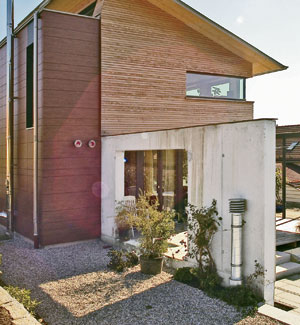Low Energy, but High Impact
Building to a benchmark
To qualify for certification a building must meet three basic criteria, which are the same for all projects, regardless of location or climate: annual energy consumption for heating and cooling is limited to 4,755 Btu per square foot; air infiltration is set at a maximum of 0.6 air changes per hour at 50 pascals of pressure; and annual primary energy usage (energy consumed by appliances, lighting, and other devices not directly related to heating and cooling) is capped at 11.1 kilowatt hours per square foot.
|
|||||
 |
|||||
| WALL 1 Facade board 8 mm Battens/air gap 40 mm Permeable sheathing 16 mm Engineered-wood joists with cellulose insulation 356 mm Oriented strand board 15 mm Air gap 60 mm Drywall 15 mm |
WALL 2 Larch wood siding 24 mm Battens/air gap 30 mm Permeable sheathing 16 mm Engineered-wood joists with cellulose insulation 356 mm Oriented strand board 15 mm Air gap 40 mm Drywall 15 mm |
||||
| ROOF 1 Photovoltaic panels Battens/air gap 30 mm Horizontal battens 40 mm Permeable sheathing 16 mm Engineered-wood joists with cellulose insulation 356 mm Oriented strand board 15 mm Air gap 24 mm Drywals 15 mm |
ROOF 2 Roof membrane Oriented strand board 22 mm Engineered-wood joists with cellulose insulation 356 mm Oriented strand board 15 mm Air gap 24 mm Drywall 15 mm |
||||
Â
The Btu and air-infiltration limits are around 10 times more stringent than those for a home built to the International Residential Code, and the primary energy limit is one-third of the average U.S. residence's consumption. Reaching the targets usually requires wrapping the building in a thick, superinsulated overcoat; sealing it in an airtight envelope; taking advantage of passive heating and cooling; and using high-efficiency appliances and fixtures.
Although it's not a prerequisite, a trained Passive House consultant often guides the process. He or she advises on ways to meet the standard, evaluates the building using software in the Passive House Planning Package (PHPP), and prepares project documentation for final certification by the Passive House Institute. Passive House consultants are required to have a basic knowledge of building science and must complete a nine-day intensive course.
In 2008, German-born architect Katrin Klingenberg cofounded the Passive House Institute US (PHIUS) in Urbana, Illinois. Since then, the concept has gone from the green building fringes to a movement with more than 200 PHIUS-qualified Passive House consultants across the country. PHIUS has certified 13 houses to date with at least 40 more in process.
One of the projects awaiting certification is an addition to a 181-year-old farmhouse in Freeman Township, Maine, designed by New York City-based BriggsKnowles Architecture + Design. The new piece makes subtle geometric shifts and is articulated with clean, planar detailing. "The form of the house, with its simple aggregated volumes, is in keeping with the typology of this area of Maine," says firm partner Laura Briggs, adding that the design's low skin-to-volume ratio helps keep heat loss to a minimum.
A code-built house in this region typically would have walls with a thermal resistance, or R-value, of 20. The roof would be about R-38, and the basement slab around R-10. But the BriggsKnowles project has R-49 walls, a roof that is R-57, and R-74 beneath the concrete-slab floors. To reach those values, the architects used engineered-wood-joist framing filled with blown-in cellulose insulation for both the walls and the roof. Then they wrapped the entire box in 21/2 inches of rigid insulation, helping to minimize thermal bridging of the more conductive wood members. Under the floor slab they placed 16 inches of rigid insulation. The amount of insulation keeps surface temperatures close to the interior air temperature, so even the exposed concrete floors, important for thermal mass, don't feel cold to the touch.
One of the biggest issues with early superinsulated houses was indoor air quality. Loose construction allows more fresh-air infiltration and helps to dissipate contaminants that "off-gas" from materials or are emitted from other indoor sources. But infiltration comes at a high price in heat loss. The Passive House system resolves this conundrum with an efficient air-to-air heat exchanger that warms or cools incoming fresh air. The BriggsKnowles team opted for a U.S.-made Energy Recovery Ventilator (ERV), which has the capacity to pull humidity from the incoming air. A simpler Heat Recovery Ventilator (HRV) can be used in climates where humidity is less of a concern. Both HRVs and ERVs need to be at least 75 percent efficient in recovering thermal energy, according to Passive House guidelines.










